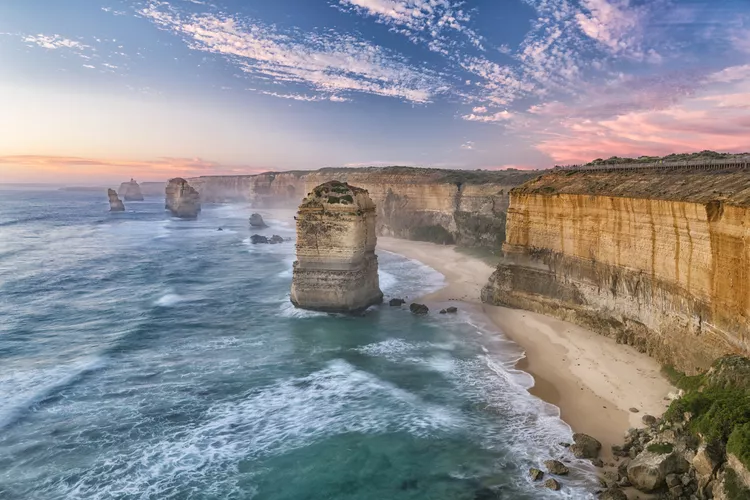Summary
The Great Ocean Road: An Unforgettable Journey
The Great Ocean Road is undeniably one of the world’s most stunning drives. Similar to California’s Highway 1, this picturesque route should be on every traveler’s bucket list. Along the way, you will encounter breathtaking cliffs at Port Campbell National Park, historic lighthouses, and the iconic Twelve Apostles. Furthermore, keep an eye out for unique Australian wildlife such as kangaroos, koalas, parrots, and penguins in the crystal-clear waters, where glances towards Antarctica are not uncommon.
You can rent a car to explore this scenic drive independently, or alternatively, you can opt for a guided tour that can take you along the Great Ocean Road for a day or even a few days.
The Top Great Ocean Road Sights
A typical Great Ocean Road tour commonly starts in Geelong or Torquay (to the east) and continues to Warrnambool (to the west), reconnecting with Princes Highway or Port Fairy. If you decide to take a tour bus from Melbourne, you will likely make stops at several highlights, including:
- Bells Beach: This beach, known for its surf culture, was featured in the film Point Break, although the movie was not shot here. Surfers have flocked to this spot for decades, while Great White Sharks have occasionally been spotted nearby.
- Port Campbell National Park: Look for Australian wildlife like kangaroos at Anglesea, koalas and parrots at Kennet Township, and penguins by the shore.
- Apollo Bay: Take a lunch break in this charming coastal town, which is a popular stop for tour buses.
- Otway Lighthouse: Spend the night in this historic lighthouse or stroll down to enjoy the breathtaking ocean views.
- Otway National Park: Hike into the lush mountains and rainforest, then enjoy further ocean views.
- The Twelve Apostles: The iconic limestone stacks that define this scenic route.
Tour Buses on the Great Ocean Road
Several tour companies operate along the Great Ocean Road, typically providing services that include a friendly driver and pick-up/drop-off at your accommodation. Most tours also include a morning tea break and any entrance fees, such as those for Otway National Park. Many tours offer an optional helicopter ride over the Twelve Apostles for an additional fee.
For those who are wondering which tour company to choose, Oz Experience remains a great option despite rumors of changes in the landscape. You may also find various alternatives through other tour providers.
Australian Animals Along the Great Ocean Road
Spotting Australian wildlife along the Great Ocean Road can be as simple as pulling over. Your tour bus driver may stop at Kennet River Township, where you can expect to see koalas, crimson rosellas, and even possibly anteaters.
The crimson rosella, a colorful parrot native to the region, is often spotted in the early mornings or late afternoons. You may even have an opportunity to feed them with birdseed handed out by your guide.
Koalas are abundant in the eucalyptus forests, and due to their slow-moving nature, you will likely encounter them. However, take care to respect their space, as they are still wild animals.
Split Point Lighthouse at Otway National Park
Constructed in 1891, the Split Point Lighthouse at Otway National Park was originally known as the Eagles Nest Point lighthouse. Explore the tip of the spit for breathtaking views of Australia’s Shipwreck Coast, a region marked by the remnants of over 700 sunken vessels.
The Great Otway National Park showcases a mesmerizing landscape, from rainforest slopes to stunning coastal views. Tourists on a Great Ocean Road trip may enjoy a tea break at the park’s rest area, offering picturesque scenery reminiscent of a painting.
Great Ocean Road History
The southwestern coast of Victoria has a rich history, initially inhabited by the Wathaurong and Katabanut tribes. It wasn’t until 1802 that European settlement began with English Lieutenant John Murray. By 1919, efforts to construct the Great Ocean Road were underway, primarily employing nearly 3,000 soldiers returning from World War I. The road was officially opened in 1932 and stands today as a tribute to those who served.
Port Campbell National Park
About 10 to 20 million years ago, the limestone that shaped this region began forming. The iconic cliff formations visible today resulted from the forces of nature, as waves and rainfall eroded the limestone to create these stunning coastal features, including the famous Twelve Apostles and London Bridge.
Twelve Apostles Aerial View From a Helicopter
Whether you’re driving or partaking in a bus tour, you can stop near Port Campbell National Park to experience a helicopter flight over the Twelve Apostles, a highlight of this scenic adventure.
Originally known as the Sow and Piglets, only seven apostles remain standing after recent erosions. A scenic helicopter flight typically costs around $10 per minute, with flights available through local operators.





